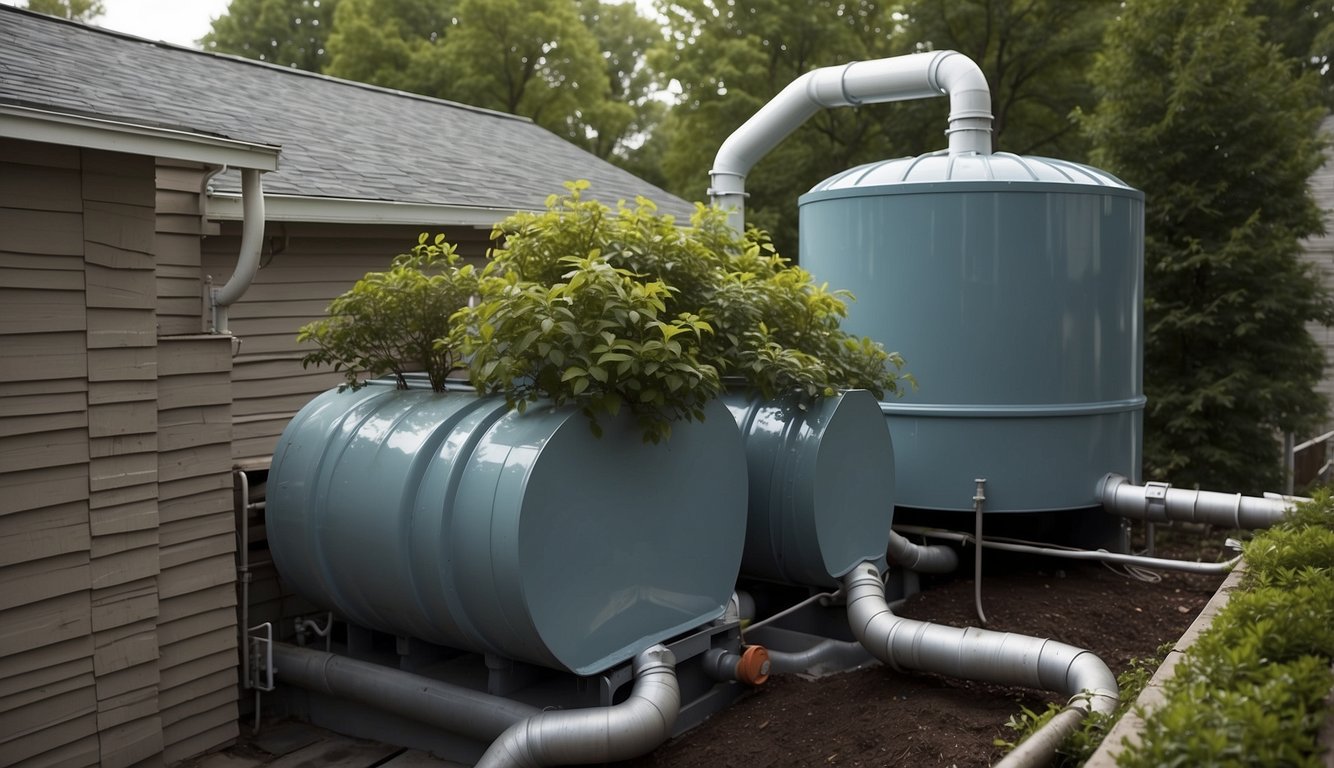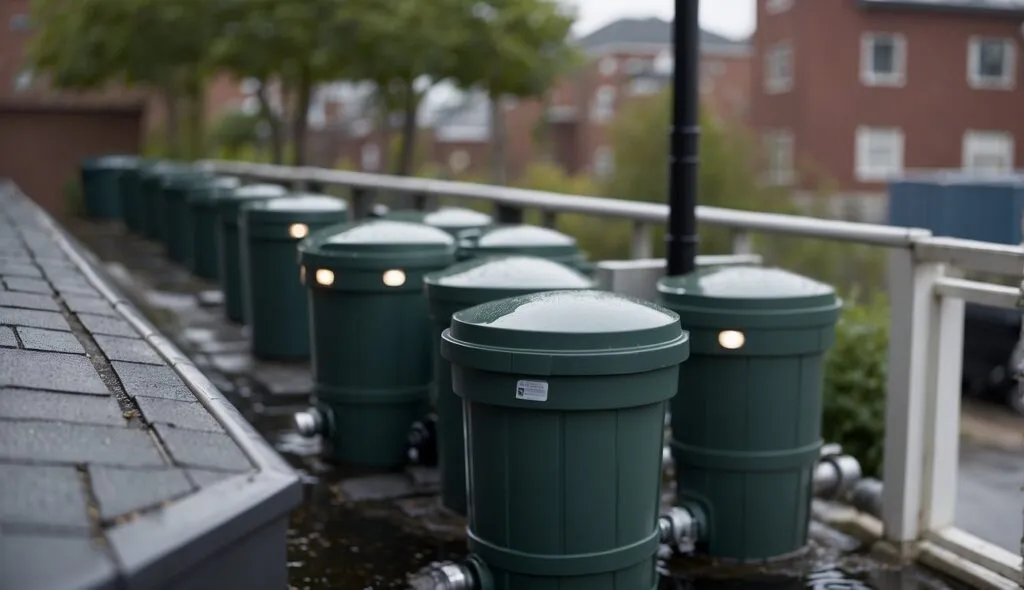Urban rainwater harvesting is a sustainable solution to water management challenges. With water scarcity becoming a growing concern, it is essential to explore alternative sources of water. Rainwater harvesting involves collecting and storing rainwater for reuse, and it is a simple yet remarkably effective technique that has been used for centuries.

Understanding rainwater harvesting is the first step towards designing collection and storage systems that are efficient and effective. There are many benefits to rainwater harvesting, such as reducing water bills, conserving water, and providing a backup source of water during emergencies. However, there are also risks associated with rainwater harvesting, such as contamination and storage issues, which must be managed and mitigated.
In this article, we will explore the benefits of rainwater harvesting, the design and management of collection and storage systems, and the applications of rainwater harvesting in urban and agricultural spaces. We will also answer some frequently asked questions about rainwater harvesting. By the end of this article, you will have a better understanding of how rainwater harvesting can be a sustainable solution to water management challenges.
Table of Contents
Key Takeaways
- Rainwater harvesting is a sustainable solution to water management challenges.
- Understanding the benefits, design, and management of collection and storage systems is essential for effective rainwater harvesting.
- Rainwater harvesting can be applied in urban and agricultural spaces to conserve water and reduce water bills.
Understanding Rainwater Harvesting
As urban dwellers, we are always looking for ways to live sustainably and reduce our carbon footprint. One ancient practice that has been gaining popularity in recent years is rainwater harvesting. This practice involves collecting and storing rainwater for later use, typically from rooftops and other impervious surfaces.
Rainwater harvesting can be done in a variety of ways, from simple rain barrels to more complex collection systems such as cisterns and rainwater collection systems. The key is to have a catchment area that allows rainwater to be collected and stored for later use.
One of the benefits of rainwater harvesting is that it can help reduce water bills and conserve water resources. By collecting rainwater, we can use it for a variety of purposes such as watering plants, washing cars, and flushing toilets, reducing the amount of water we draw from municipal water supplies.
When setting up a rainwater harvesting system, it’s important to consider the size of the catchment area, the type of collection system, and the storage capacity. A larger catchment area will allow for more rainwater to be collected, while a larger storage capacity will allow for more water to be stored for later use.
Overall, rainwater harvesting is a simple yet effective way to live sustainably and reduce our impact on the environment. By collecting rainwater, we can reduce our water bills, conserve water resources, and live more sustainably.
Benefits of Rainwater Harvesting
Rainwater harvesting offers numerous benefits for us as individuals, communities, and the environment. Here are some of the key benefits:
Conserves Water: By capturing and storing rainwater, we can reduce our reliance on municipal water sources and conserve this precious resource. This is especially important in areas where water scarcity is a concern.
Reduces Water Bills: By using stored rainwater for non-potable purposes such as irrigation or flushing toilets, we can reduce our water bills and save money.
Improves Water Quality: Rainwater is naturally clean and free of many contaminants found in municipal water sources. By using rainwater for non-potable purposes, we can reduce the demand for treated water and improve the overall quality of our water supply.
Promotes Sustainability: By reducing our reliance on municipal water sources, we can promote a more sustainable future. Rainwater harvesting is a simple yet effective way to reduce our impact on the environment and promote a more sustainable way of life.
Reduces Flooding and Erosion: By capturing and storing rainwater, we can reduce the amount of runoff that contributes to flooding and erosion. This is especially important in urban areas where impervious surfaces such as roads and buildings prevent rainwater from infiltrating the ground.
Increases Self-Sufficiency: By capturing and storing rainwater, we can increase our self-sufficiency and resilience in the face of water scarcity or other emergencies.
In summary, rainwater harvesting offers numerous benefits for us as individuals, communities, and the environment. By conserving water, reducing water bills, improving water quality, promoting sustainability, reducing flooding and erosion, and increasing self-sufficiency, rainwater harvesting is a simple yet effective way to address many of the water management challenges we face today.
Designing Collection and Storage Systems

When it comes to designing a rainwater harvesting system, there are several key components to consider. These include gutters and downspouts, tanks and cisterns, and filtration and purification systems. By carefully selecting and designing each of these components, we can create a highly efficient and effective rainwater harvesting system that meets our needs.
Gutters and Downspouts
The first step in designing a rainwater harvesting system is to ensure that we have adequate gutters and downspouts in place. Gutters should be properly installed and sloped to ensure that rainwater flows freely towards the downspouts. Downspouts should be positioned to direct water into the collection system and away from the foundation of the building.
Tanks and Cisterns
The next step is to select an appropriate water storage container. Tanks and cisterns come in a variety of sizes and materials, including plastic, concrete, and metal. It’s important to choose a container that is large enough to meet our needs, but not so large that it becomes difficult to maintain or too expensive to install. The location of the container is also important, as it should be positioned to collect as much rainwater as possible while remaining accessible for maintenance and cleaning.
Filtration and Purification
Finally, we need to consider the filtration and purification systems that we will use to ensure that the collected rainwater is safe and clean for use. This may include pre-filtration systems, such as first-flush diverters, which remove debris and contaminants from the initial runoff. We may also need to install a water filtration system, such as a sand or carbon filter, to remove any remaining impurities. Water purification systems, such as UV sterilizers or chlorinators, may also be necessary to ensure that the water is safe for drinking.
Overall, designing an effective rainwater harvesting system requires careful consideration of each of these components. By selecting the right gutters and downspouts, tanks and cisterns, and filtration and purification systems, we can create a highly efficient and effective system that meets our needs for water conservation and sustainability.
Managing and Mitigating Risks

Urban rainwater harvesting has numerous benefits, but it also comes with some risks. In this section, we will discuss how to manage and mitigate these risks.
Preventing Contamination
One of the main risks associated with rainwater harvesting is contamination. Rainwater can pick up pollutants and bacteria as it flows across impervious surfaces, such as roads and rooftops. To prevent contamination, it is essential to install a first flush diverter. This device diverts the first flush of rainwater away from the storage tank, which is typically the most contaminated.
It is also important to keep the storage tank clean. Regular maintenance, such as cleaning and disinfecting the tank, can prevent the growth of bacteria and pathogens. We recommend cleaning the tank at least once a year or more frequently if necessary.
Addressing Overflows and Flooding
Another risk associated with rainwater harvesting is overflows and flooding. If the storage tank overflows, it can cause flooding and erosion around the tank. To prevent overflows, it is important to size the storage tank appropriately. The tank should be large enough to capture the expected amount of rainfall, but not so large that it overflows during heavy rainfall events.
It is also essential to design the system to handle excess water. One way to do this is to include an overflow pipe that directs excess water away from the tank. Additionally, it is important to design the system to prevent backflow, which can occur when the tank is full, and water flows back into the downspout and onto the roof.
Managing and mitigating risks associated with rainwater harvesting is crucial to ensure the safety and effectiveness of the system. By preventing contamination and addressing overflows and flooding, we can reap the benefits of rainwater harvesting while minimizing the risks.
Applications in Urban and Agricultural Spaces
Urban rainwater harvesting is a game-changer for both urban and agricultural spaces. It can help us reduce our reliance on municipal water supplies, reduce stormwater runoff, and provide a sustainable source of water for our gardens and farms. Here are some applications of rainwater harvesting in urban and agricultural spaces:
Urban Gardens
Urban gardens are an excellent place to implement rainwater harvesting systems. Rainwater can be collected from rooftops and stored in rain barrels or cisterns. This water can then be used to water plants, reducing the need for municipal water. It is also a great way to reduce stormwater runoff and prevent erosion.
Agriculture
Rainwater harvesting can also be used in agricultural spaces to provide a sustainable source of water for crops. It can help us reduce our reliance on groundwater and surface water sources. Rainwater can be collected from rooftops or from fields and stored in cisterns or ponds. This water can then be used for irrigation, reducing the need for municipal water.
Rain Gardens
Rain gardens are designed to capture and absorb rainwater runoff from roofs, driveways, and other impervious surfaces. They are planted with native plants that are adapted to local climate and soil conditions. Rain gardens can help reduce stormwater runoff, improve water quality, and provide habitat for wildlife.
Green Roofs
Green roofs are becoming increasingly popular in urban spaces. They are covered with vegetation, creating a natural habitat for plants and wildlife. Green roofs can also help reduce stormwater runoff, improve air quality, and provide insulation for buildings.
Existing Structures
Rainwater harvesting can be incorporated into existing structures, such as homes and commercial buildings. Rainwater can be collected from rooftops and stored in cisterns or tanks. This water can then be used for non-potable uses, such as irrigation, toilet flushing, and laundry.
Smart Water
Smart water systems can help us manage our water use more efficiently. They can monitor water use, detect leaks, and adjust irrigation schedules based on weather conditions. Smart water systems can also help us reduce our water bills and conserve water.
Urban Gardeners
Urban gardeners can benefit from rainwater harvesting by reducing their reliance on municipal water supplies. Rainwater can be collected from rooftops and stored in rain barrels or cisterns. This water can then be used to water plants, reducing the need for municipal water. It is also a great way to reduce stormwater runoff and prevent erosion.
Conclusion
In conclusion, we hope that this article has provided you with valuable information on urban rainwater harvesting. By implementing these tips, we can efficiently and sustainably manage our water resources while adhering to local regulations.
Traditional rainwater harvesting methods have been used for centuries and can be easily adopted in both urban and rural areas. By using rainwater for non-potable uses such as irrigation, we can reduce our reliance on expensive and energy-intensive municipal water sources.
One of the biggest advantages of rainwater harvesting is that it is a free source of water. By installing a rainwater harvesting system, we can collect and store rainwater for future use. These systems require low maintenance and can provide a reliable source of water during times of drought or water restrictions.
It is important to note that the efficiency of rainwater harvesting systems can vary depending on factors such as climate, roof area, and storage capacity. It is crucial to design and maintain these systems properly to ensure optimal performance.
Overall, rainwater harvesting is a simple and effective way to conserve water and reduce our impact on the environment. By taking advantage of this free and abundant resource, we can work towards a more sustainable future.
Frequently Asked Questions
What are the best practices for implementing rainwater harvesting in urban areas?
When implementing rainwater harvesting in urban areas, it is important to consider the available space, the amount of rainfall, and the intended use of the harvested water. Some best practices include using a rain barrel or cistern to collect water from rooftops, installing a rain garden or bioswale to capture runoff, and using permeable surfaces to allow rainwater to infiltrate the ground. It is also important to follow local regulations and obtain any necessary permits before installing a rainwater harvesting system.
How can homeowners in California optimize rainwater harvesting in urban settings?
Homeowners in California can optimize rainwater harvesting in urban settings by selecting drought-tolerant plants, using mulch to retain moisture, and installing a drip irrigation system to water plants with harvested rainwater. Additionally, homeowners can take advantage of rebates and incentives offered by local water agencies to offset the cost of installing a rainwater harvesting system.
What are the essential considerations for beginners starting urban rainwater harvesting?
For beginners starting urban rainwater harvesting, it is important to consider the size of the collection system, the intended use of the harvested water, and the maintenance requirements of the system. It is also important to select a location that is easily accessible for maintenance and that receives adequate rainfall. Beginners should also be aware of any local regulations and obtain necessary permits before installing a rainwater harvesting system.
How can you create a DIY rainwater harvesting system in an urban environment?
Creating a DIY rainwater harvesting system in an urban environment can be done using a variety of materials such as a plastic barrel, PVC piping, and a spigot. The system can be connected to a downspout to collect rainwater from the roof and filtered using a screen or mesh to remove debris. The harvested water can be used for watering plants, washing cars, and other non-potable uses.
What are the key components of a residential rainwater collection system?
The key components of a residential rainwater collection system include a collection surface, such as a roof or pavement, a conveyance system, such as gutters and downspouts, a storage container, such as a cistern or rain barrel, and a distribution system, such as a pump or gravity-fed hose. Other components may include filters, screens, and overflows to prevent flooding.
What are some common challenges and solutions in urban rainwater harvesting projects?
Common challenges in urban rainwater harvesting projects include limited space, lack of rainfall, and high upfront costs. Solutions to these challenges include using smaller collection systems, selecting drought-tolerant plants, and taking advantage of rebates and incentives offered by local water agencies. It is also important to consult with a professional to ensure that the system is designed and installed correctly.


